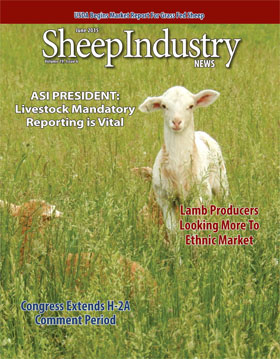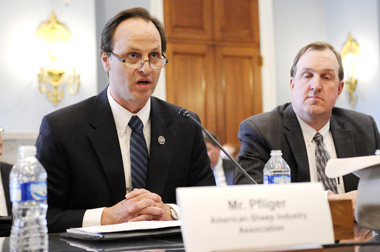
- June 2015
- President’s Notes
- Congress Extends H-2A Period
- Theos Family Reaching Niche Lamb Market
- Market Report
- Australian Wool Market Rallied; U.S. Gains
- USDA Begins Releasing Grass Fed Report
- Clark Willis Obituary
- Region IV Bighorn Plan Implemented in Utah
- Western Lawmakers Team to De-List Wolves
- ASI Photo Contest
- ASI Supports COOL For Lamb
- Battle Not Over in Sage Grouse Fight
- Livestock Mandatory Reporting
- No Grazing This Summer
- Separate Efforts: Scrapie Eradication Program and the Animal Disease Traceability Program
- Lamb Producers Look to Ethnic Groups
- Study Explores Disease in Grand Canyon Bighorns
- Sheep News In Brief
ASI President Urges Congressional Committee to Re-Authorize Livestock Mandatory Reporting
Editor’s note: Below in full is the statement of ASI President Burton Pfliger on Mandatory Price Reporting for Livestock before the Subcommittee on Livestock, Rural Development and Credit Committee on Agriculture in the U.S. House of Representatives. Pfliger’s statement was given April 23.
“Mr. Chairman and members of the subcommittee, thank you for the opportunity to speak with you today. I’m Burton Pfliger, a sheep producer from North Dakota and president of the American Sheep Industry Association (ASI). ASI is the national trade association for the U.S. sheep industry representing the 80,000 farm and ranch families who raise sheep.
 Our association celebrates its 150th anniversary this year. ASI and our predecessor, the National Wool Growers Association, have continuously advocated for sheep ranchers since 1865, meaning we are among the oldest national livestock organizations in America. The sheep industry of the United States produces lamb and wool in every part of the country.
Our association celebrates its 150th anniversary this year. ASI and our predecessor, the National Wool Growers Association, have continuously advocated for sheep ranchers since 1865, meaning we are among the oldest national livestock organizations in America. The sheep industry of the United States produces lamb and wool in every part of the country.
The industry provides nearly a billion dollars in farm and ranch gate sales to the American economy, and is a mainstay of the many rural communities in which sheep ranchers and farmers are foundational members.
Livestock Mandatory Reporting (LMR) is very important to our industry and we strongly urge Congress to reauthorize the LMR Act before September 30, 2015. There is unity across the various sectors (production, feeding, processing) of the U.S. sheep industry that LMR is essential for timely and transparent marketing and pricing information. USDA does a good job with the voluntary reporting program conducted by the Ag Marketing Service/Market News Division that is complimentary to LMR but history has proved that voluntary reporting is not sufficient in today’s marketing environment without LMR. I remember that as USDA was in the process crossing the hurdles of implementing LMR originally in 2001 and when reauthorization lapsed twice since, timely market information was not available to the sheep industry trade and irrational price volatility occurred that can easily be correlated to the lack of market information during those periods.
As with the hog and cattle sectors, the sheep industry has experienced consolidation and the processing sector has become more concentrated. One dynamic that is different for our industry compared to beef and pork is that imported lamb makes up half of what is available to U.S. consumers today. This fact alone makes LMR data critically important to our industry.
As you know, the statutory authority regarding lamb in the LMR Act is only one sentence long and provides USDA with much discretion in providing price-reporting information. Thus, all of the lamb price reporting requirements have been done by regulation. The regulation for lamb reporting has been amended once over the years (2008).
As we have watched industry dynamics change and as all sectors of the sheep industry have become more dependent upon LMR information, ASI decided to commission a study of LMR for lamb—- -what is working, what needs improving, etc. In December of 2012 the Livestock Marketing Information Center delivered a report to us (I’m submitting a copy for the record.) and we began an 18-month process of meeting weekly at times with USDA’s Ag Marketing Service to work through the issues raised in the report. We believe this was a very helpful exercise for our industry and I believe it also served to bring some needed attention to the LMR regulations for lamb by AMS.
In mid-2014 ASI, in consultation with LMIC, sent final recommendations to USDA/AMS (I’m submitting a copy of this document also for the record.) While we were hopeful that a proposed amendment to the LMR regulation for lamb would be published, we understand now that this process will be considered once the statute is reauthorized.
Many of the issues raised in the report are very important to ASI and we are optimistic/confident that USDA will include these changes in the final regulations. In the interest of maintaining USDA’s broad discretionary authority to implement mandatory price reporting for lamb, we are not requesting statutory authority requiring USDA to implement many of these changes. However, there are a few that direction to USDA (either statutorily or in report language) would be most helpful. Briefly, at the top of our list of enhancements that are needed for LMR reporting for lamb are: Lower the reporting thresholds for imported and domestic lamb meat.
As I mentioned earlier, half of the lamb sold in the U.S. is imported and with the current reporting threshold we don’t have a reasonable market test of many cuts of imported lamb. With domestic reporting, the larger processors are getting larger and there are several mid-size processors going into business.
We believe the addition of the mid-size processors will add valuable price information. With both imported and domestic thresholds, we believe it is important to look prospectively at industry trends rather than only historic size levels.
Revise the confidentiality rules that are in place and/or provide for some alternative methods for reporting prices as the processing sector becomes more concentrated.
One of the cases when LMR reporting on lamb was not available was due to one firm not voluntarily agreeing to report during a lapse in statutory reauthorization with the 3-70-20 rule being applied. This incident demonstrates how close to the line our industry is using the 3-70-20 rule. Surely there must be ways to protect confidentiality yet provide for the full intent of LMR as we look ahead to how businesses and market dynamics may change.
Revise the definition of “packer-owned” and build some flexibility in the regulation that will provide for price reporting as marketing arrangements change within the industry. The U.S. sheep industry is not necessarily unique in that the marketing continuum is not as linear as it once was.
Processors and their suppliers and even their customers are engaging in marketing arrangements that are different than they were 50, 25 or even 15 years ago when LMR was authorized.
Today about 30 percent of the U.S. lambs are processed by one cooperative and because of the intricacies of their business model, USDA will not allow LMR on their lambs even though there are recorded transactions and the coop wants to report!
Ensure that USDA has the ability to issue reports even during times of a lapse in appropriations (aka an emergency furlough). During the last shutdown of USDA when there was a lapse of appropriations, the Secretary determined that LMR was not an essential function.
Therefore, even though reporting is required under the LMR Act, no reports were issued which caused great consternation in the industry. Although we believe that current statutory authority is sufficient to allow the Secretary to continue reporting during such times, we support efforts to ensure that this situation does not reoccur—either statutory language or otherwise as the Committee determines most appropriate.
In summary Mr. Chairman, we urge reauthorization of the LMR Act prior to September 30th so that there is not a lapse in price reporting.
In addition, although not raised in previous discussions on reauthorization of LMR, given the market changes that are occurring in the sheep industry I believe that it would be prudent for the Committee to consider requiring USDA to conduct a study and issue a report that would be due one year prior to the next reauthorization date.
The report should require USDA to consult with the livestock industry and make recommendations on how to better and more inclusively accomplish price reporting in the current industry and market environment.
Thank you again for the opportunity to speak and I’ll be happy to answer any questions.”

